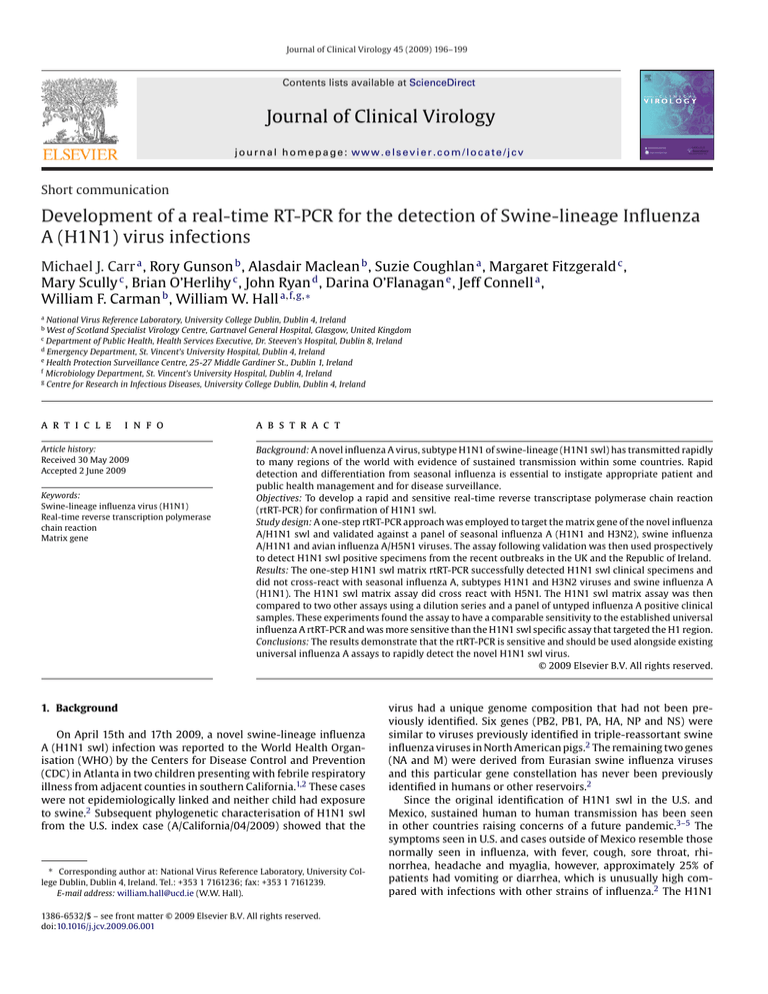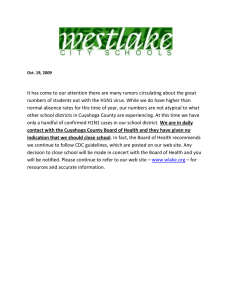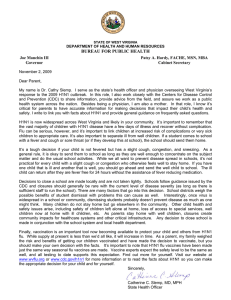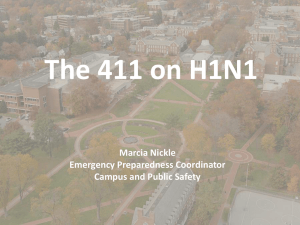
Journal of Clinical Virology 45 (2009) 196–199
Contents lists available at ScienceDirect
Journal of Clinical Virology
journal homepage: www.elsevier.com/locate/jcv
Short communication
Development of a real-time RT-PCR for the detection of Swine-lineage Influenza
A (H1N1) virus infections
Michael J. Carr a , Rory Gunson b , Alasdair Maclean b , Suzie Coughlan a , Margaret Fitzgerald c ,
Mary Scully c , Brian O’Herlihy c , John Ryan d , Darina O’Flanagan e , Jeff Connell a ,
William F. Carman b , William W. Hall a,f,g,∗
a
National Virus Reference Laboratory, University College Dublin, Dublin 4, Ireland
West of Scotland Specialist Virology Centre, Gartnavel General Hospital, Glasgow, United Kingdom
c
Department of Public Health, Health Services Executive, Dr. Steeven’s Hospital, Dublin 8, Ireland
d
Emergency Department, St. Vincent’s University Hospital, Dublin 4, Ireland
e
Health Protection Surveillance Centre, 25-27 Middle Gardiner St., Dublin 1, Ireland
f
Microbiology Department, St. Vincent’s University Hospital, Dublin 4, Ireland
g
Centre for Research in Infectious Diseases, University College Dublin, Dublin 4, Ireland
b
a r t i c l e
i n f o
Article history:
Received 30 May 2009
Accepted 2 June 2009
Keywords:
Swine-lineage influenza virus (H1N1)
Real-time reverse transcription polymerase
chain reaction
Matrix gene
a b s t r a c t
Background: A novel influenza A virus, subtype H1N1 of swine-lineage (H1N1 swl) has transmitted rapidly
to many regions of the world with evidence of sustained transmission within some countries. Rapid
detection and differentiation from seasonal influenza is essential to instigate appropriate patient and
public health management and for disease surveillance.
Objectives: To develop a rapid and sensitive real-time reverse transcriptase polymerase chain reaction
(rtRT-PCR) for confirmation of H1N1 swl.
Study design: A one-step rtRT-PCR approach was employed to target the matrix gene of the novel influenza
A/H1N1 swl and validated against a panel of seasonal influenza A (H1N1 and H3N2), swine influenza
A/H1N1 and avian influenza A/H5N1 viruses. The assay following validation was then used prospectively
to detect H1N1 swl positive specimens from the recent outbreaks in the UK and the Republic of Ireland.
Results: The one-step H1N1 swl matrix rtRT-PCR successfully detected H1N1 swl clinical specimens and
did not cross-react with seasonal influenza A, subtypes H1N1 and H3N2 viruses and swine influenza A
(H1N1). The H1N1 swl matrix assay did cross react with H5N1. The H1N1 swl matrix assay was then
compared to two other assays using a dilution series and a panel of untyped influenza A positive clinical
samples. These experiments found the assay to have a comparable sensitivity to the established universal
influenza A rtRT-PCR and was more sensitive than the H1N1 swl specific assay that targeted the H1 region.
Conclusions: The results demonstrate that the rtRT-PCR is sensitive and should be used alongside existing
universal influenza A assays to rapidly detect the novel H1N1 swl virus.
© 2009 Elsevier B.V. All rights reserved.
1. Background
On April 15th and 17th 2009, a novel swine-lineage influenza
A (H1N1 swl) infection was reported to the World Health Organisation (WHO) by the Centers for Disease Control and Prevention
(CDC) in Atlanta in two children presenting with febrile respiratory
illness from adjacent counties in southern California.1,2 These cases
were not epidemiologically linked and neither child had exposure
to swine.2 Subsequent phylogenetic characterisation of H1N1 swl
from the U.S. index case (A/California/04/2009) showed that the
∗ Corresponding author at: National Virus Reference Laboratory, University College Dublin, Dublin 4, Ireland. Tel.: +353 1 7161236; fax: +353 1 7161239.
E-mail address: william.hall@ucd.ie (W.W. Hall).
1386-6532/$ – see front matter © 2009 Elsevier B.V. All rights reserved.
doi:10.1016/j.jcv.2009.06.001
virus had a unique genome composition that had not been previously identified. Six genes (PB2, PB1, PA, HA, NP and NS) were
similar to viruses previously identified in triple-reassortant swine
influenza viruses in North American pigs.2 The remaining two genes
(NA and M) were derived from Eurasian swine influenza viruses
and this particular gene constellation has never been previously
identified in humans or other reservoirs.2
Since the original identification of H1N1 swl in the U.S. and
Mexico, sustained human to human transmission has been seen
in other countries raising concerns of a future pandemic.3–5 The
symptoms seen in U.S. and cases outside of Mexico resemble those
normally seen in influenza, with fever, cough, sore throat, rhinorrhea, headache and myaglia, however, approximately 25% of
patients had vomiting or diarrhea, which is unusually high compared with infections with other strains of influenza.2 The H1N1
M.J. Carr et al. / Journal of Clinical Virology 45 (2009) 196–199
197
Table 1
Primer and probes sequences for the generic influenza A and the H1N1 swl rtRT-PCR assays.
Virus target
Target gene
Forward primer
Reverse primer
Probe
Generic Influenza A
Influenza A H1N1 swl
Matrix
Matrix
AAGACAAGACCAATYCTGTCACCTCT
TGTGCCACTTGTGAACAGATTG
TCTACGYTGCAGTCCYCGCT
CTGATTAGTGGATTGGTGGTAGTAGC
FAM-TYACGCTCACCGTGCCCAGTG-BHQ
HEX-5 TGATTCACAGCATCGGTCTCACAGACAG 3 -BHQ
swl NA gene segments sequenced to date suggests that the virus is
fully susceptible to the neuraminidase inhibitors, oseltamivir and
zanamivir; however, M gene sequencing has shown resistance to
the adamantanes.6
The emergence of the H1N1 swl virus has ramifications for existing diagnostic and typing PCR methods as the genetic differences
mentioned above may result in a failure to detect and/or type this
new virus. Most influenza A PCR assays in use in the United Kingdom target conserved regions of the M gene and therefore should
detect influenza A from all established subtypes, including the
newly emergent H1N1 swl. However, such methods need to be complimented with a rapid typing test to distinguish seasonal influenza
A from H1N1 swl.
This article describes the development of an M gene-based
H1N1 swl real-time reverse transcriptase polymerase chain reaction (rtRT-PCR) assay that does not cross-react with human seasonal
influenza A viruses (subtypes H1N1 and H3N2). We have used this
technique to confirm H1N1 swl infection and to identify transmission events of this novel virus.
2. Objectives
To develop a rapid and sensitive rtRT-PCR for confirmation of
H1N1 swl. To validate the potential for cross reactvity to seasonal influenza A/H1N1 and H3N2, enzootic swine A/H1N1 and
avian A/H5N1. To compare the end point detection limit of the
newly developed assay against an established diagnostic assay that
detects all influenza A viruses and a recently published H1N1 swl
specific typing method. To prospectively test specimens from recent
confirmed cases of H1N1 swl in the United Kingdom and the Republic of Ireland and finally to compare the newly developed assay to
an H1N1 swl specific typing assay on 52 clinical samples that were
influenza A positive but untyped at the time of testing.
3. Study design
The H1N1 swl rtRT-PCR assay was designed to target segment 7 encoding the matrix protein 1 gene using the sequence
of A/California/04/2009 (FJ969513) and Primer Express version 3.0
(Applied Biosystems). The chosen primers (see Table 1) amplify
an 80-bp amplicon and bioinformatics analysis using BLAST and
Clustal alignments showed no significant homology to human gene
sequences and numerous mutations present in the homologous
M gene region in seasonal influenza A, subtypes H1N1 and H3N2
viruses.
The specificity of the assay was assessed retrospectively using
a panel of seasonal influenza A, H1N1 and H3N2 samples (n = 7)
and swine A/H1N1 and avian A/H5N1 viruses were also included
in the panel. A pool containing the following commonly encountered respiratory pathogens was also tested: influenza B, influenza
C, parainfluenza 1–4, human metapneumovirus, respiratory syncytial virus, Mycoplasma pneumoniae, rhinovirus and coronaviruses
229E, OC43 and NL63.
The end-point detection limit of the new H1N1 swl rtRT-PCR
was directly compared to a widely used universal influenza A rtRTPCR assay and a H1N1 swl H1 specific rtRT-PCR using a dilution
series of a H1N1 swl clinical sample. The universal influenza A rtRTPCR assay targets the matrix region of the virus and is in use as
the frontline diagnostic test for influenza A virus detection at both
Glasgow and Dublin virology laboratories. Participation in various
EQA schemes has shown this assay to detect influenza A viruses
from humans and animals with high sensitivity. The H1N1 swl H1
specific rtRT-PCR has been implemented by most Health Protection
Agency affiliated laboratories in England.7
The H1N1 swl matrix assay was then assessed prospectively
from the end of April 2009. In the West of Scotland Specialist Virology Centre the assay was ran alongside the routine influenza A
rtRT-PCR and was used to test all samples from suspected cases and
contacts of H1N1 swl cases. In Dublin the assay was used to test any
samples that were influenza A positive that could not be typed by
a influenza A H1 or H3 rtRT-PCR. Any samples tested as H1N1 swl
positive using the H1N1 swl assay were then tested by sequencing or submitted to the Health Protection Agency for confirmation
purposes.
The final assessment comprised of comparing the H1N1 swl
matrix assay with the H1N1 swl H1 specific assay on 52 samples
that were influenza A positive using the universal influenza A rtRTPCR. All samples were sent to the WOSSVC during the first week of
June, 2009 and were taken from contacts with confirmed cases of
H1N1 swl. All were untyped at the time of testing. Total nucleic acid
was extracted from respiratory specimens using QIAamp Viral RNA
Mini kit (Qiagen, Crawley, United Kingdom) according to the manufacturer’s instructions. The oligonucleotide primers and probe
(TIB-MOLBIOL, Berlin, Germany) for the both the H1N1 swl and the
universal influenza A rtRT-PCR assays are outlined in Table 1. Both
assays used the primers at a final concentration of 400 nM and the
probe at 200 nM in a 15 l or 25 l reaction volume. One-step rtRTPCR was performed on 6 l or 5 l of RNA extract with the Platinum
One-step qRT-PCR kit (Invitrogen) on an ABI Prism 7500 SDS realtime platform (Applied Biosystems). The following thermal profile
was used: a single cycle of reverse transcription for 15 min at 50 ◦ C,
2 min at 95 ◦ C for reverse transcriptase inactivation and DNA polymerase activation followed by 40 amplification cycles of 15 s at 95 ◦ C
and 34 min at 60 ◦ C each (annealing-extension step). The H1N1 swl
H1 specific rtRT-PCR was carried out as described elsewhere.7 Data
acquisition occurred at the annealing step of each cycle and the
threshold cycle (Ct) for each sample was calculated by determining
the point at which the fluorescence exceeded the threshold limit.
4. Results
The specificity of the H1N1 swl matrix protein 1 gene assay was
evaluated using a panel comprising seasonal influenza A (H1N1
and H3N2), avian (H5N1) and swine (H1N1) influenza A viruses
(Table 2). No cross-reaction with seasonal influenza A (H1N1 and
Table 2
Evaluation of the specificity of the H1N1 swl rtRT-PCR assay.
Influenza A subtype
Influenza A universal
H1N1 swl
H3N2
H3N2
H3N2
H3N2
H1N1
H1N1
H1N1
Avian H5N1
Swine H1N1
28.19
25.00
30.05
28.20
27.18
27.38
31.81
26.41
21.95
Neg
Neg
Neg
Neg
Neg
Neg
Neg
37.02
Neg
198
M.J. Carr et al. / Journal of Clinical Virology 45 (2009) 196–199
Table 3
Dilution series comparing the end-point detection limit of the H1N1 swl assay to
the universal influenza A assay.
Table 5
Comparison of the H1N1 swl matrix assay and the H1N1 swl H1 assay on 52 influenza
A (untyped) positive clinical samples.
Dilution
Influenza A universal
H1N1 swl
Number of samples
Universal Flu
H1N1 swl matrix
H1N1 swl H1
Neat sample
10−1
10−2
10−3
10−4
10−5
10−6
29.69
33.13/33.25
36.34/38.2
38.08/37.3
Neg
Neg
Neg
31.14
33.45/34.22
37.18/36.34
Neg/37.31
Neg
Neg
Neg
46
6
+
+
+
+
+
−*
H3N2), swine influenza A (H1N1) or commonly encountered respiratory pathogens was observed. The H1N1 swl assay did, however,
cross-react with avian influenza A (H5N1; ∼Ct 37).
In comparison with the universal influenza A assay, the H1N1
swl assay was found to have a slightly lower end-point detection
limit detecting the 10−3 dilution in one out of two occasions. The
influenza A universal assay detected this 10−3 dilution on both occasions (Table 3). The H1N1 swl H1 specific rtRT-PCR was the least
sensitive of the three assays, with an endpoint ∼2 logs less than
both the universal and H1N1 swl matrix assay.
Since the emergence of H1N1 swl, and up unitll the 28th of May,
499 samples from suspected cases and contacts were tested at the
WOSSVC in Glasgow. All samples were tested using both the frontline universal matrix and the H1N1 swl rtRT-PCR assays. In total,
15 cases of influenza A were detected in Scotland by the frontline
assay in use at the WOSSVC. Of these, 4 were subtyped as seasonal
H3 (and were negative by the H1N1 swl assay). Eleven were found
to be positive by the H1N1 swl assay (Table 4) and could not be
typed using the seasonal H1 and H3 subtyping rtPCR assays. All 11
were subsequently confirmed as H1N1 swl positive by the Health
Protection Agency.
During this same period seven cases of influenza A were
detected in Ireland. Of these, four were subtyped as seasonal
influenza A (3 subtype H3 and 1 subtype H1) whereas three were
untypeable. Using the new assay these were found to be H1N1 swl
positive and also had a broad range of viral loads as evidenced by
the Ct range (samples 16–18 in Table 4; Genbank accession numbers: GQ169710 and GQ214167). The final comparison assessed
both the H1N1 swl matrix assay and the H1N1 swl H1 specific
assay on 52 clinical samples tested positive for influenza A using
the universal matrix test (Table 5). All samples were submitted to
the WOSSVC during the first week of June, 2009. Of these, all 52
typed as being H1N1 swl using the matrix assay. In total, 6 of the
Table 4
Influenza A PCR positive samples detected since the emergence of H1N1swl.
Sample
Universal Flu Ct
H1N1 swl Ct
H1/H3 Typing assay
1
2
3
4
5
6
7
8
9
10
11
12
13
14
15
16
17
18
31.58
27.5
21.24
33.27
32.01
32.57
30.9
23.28
27.64
27.4
28.7
37.09
33.27
31.79
30.3
34.05
26.22
20.68
Neg
Neg
Neg
Neg
30.87
35.47
29.15
23.22
28.63
27.8
28.7
38.38
33.87
32.62
31
34.51
27.30
18.77
33.59 (H3)
31.24 (H3)
21.92 (H3)
31.27 (H3)
Neg
Neg
Neg
Neg
Neg
Neg
Neg
Neg
Neg
Neg
Neg
Neg
Neg
Neg
*
All the samples missed by the HPA assay had Ct values >35 in the universal
influenza and the H1N1 swl matrix assays.
52 samples failed to be detected by the H1N1 swl H1 specific assay.
All of these samples had Ct values >35 in the universal influenza
and the H1N1 swl matrix assays.
5. Discussion
Major uncertainties still exist with regards to the transmissibility and virulence of H1N1 swl which warrants the development of
new methodologies to detect this virus. Established typing methods such as nucleotide sequencing are sensitive and informative
but too prolonged to influence infection control and public health
procedures. This article describes the development of a rapid and
sensitive rtRT-PCR assay that detects the emerging H1N1 swl virus.
The H1N1 swl matrix assay did not cross react with seasonal influenza A strains currently circulating (subtypes H1N1 and
H3N2), swine influenza A (H1N1) or other commonly encountered
respiratory pathogens. However, we did observe that the H1N1 swl
matrix test detected influenza A, subtype H5N1 which probably due
to avian ancestry of the Eurasian M gene in H1N1 swl. Other studies
have also highlighted its non-specificity in relation to avian strains
of influenza A7. However, since avian influenza A viruses are not
circulating in humans in the UK at present the non-specificity of
this assay should not pose a particular problem for its routine use
and any samples that have a high risk of being avian influenza positive should also be tested using a H5N1 real-time assay in order to
rule out this virus. The sensitivity of the H1N1 swl matrix assay is
comparable to the frontline universal influenza A rtRT-PCR test in
routine use at both Dublin and Glasgow. When testing the dilution
series of a clinical sample, both these assays were found to be ∼2
logs more sensitive than the H1N1 swl H1 specific rtRT-PCR assay.
The lower sensitivity of the H1N1 swl H1 specific assay was confirmed when it was compared to the H1N1 swl matrix assay on
the 52 untyped influenza A positive clinical samples. Based on the
results shown here, both the universal and the H1N1 swl matrix
assay are sensitive assays that are of great use in the detection and
typing of H1N1 swl. After implementation the assay was used to
detect 14 cases of H1N1 swl and all were confirmed as being H1N1
swl by other methods/specialist centres.
The rapidity in which the H1N1 swl diagnostic test was designed
and implemented highlights one of the main advantages of inhouse molecular diagnostic methods. This enabled both Glasgow
and Dublin to implement the assay within days of the first UK case
being detected. Its use greatly enhanced the public health response
to the emergence of H1N1 swl in Scotland and the Republic of
Ireland as we were able to rapidly screen samples from patients
with suspected travel-associated H1N1 swl. As a result those with
infection could be identified quickly and public health interventions implemented to minimise the risk of potential spread. The
test was also useful for screening the contacts of these cases and
played an important role in detecting the transmission of H1N1
swl from either the index cases and from contact to contact.
Conflicts of interest
The authors declare no conflicts of interest.
M.J. Carr et al. / Journal of Clinical Virology 45 (2009) 196–199
Acknowledgments
We would like to thank the staff of the West of Scotland Specialist Virology Centre, Glasgow and the National Virus Reference
Laboratory, University College Dublin who carried out the influenza
testing and subtyping assays.
References
1. CDC. Update: infections with a swine-origin influenza A (H1N1) virus—United
States and other countries, April 28, 2009. MMWR Morb Mortal Wkly Rep
2009;58:431–3.
2. Novel Swine-Origin Influenza A (H1N1) Virus Investigation Team. Emergence of
a Novel Swine-Origin Influenza A (H1N1) virus in humans. N Engl J Med; in press.
199
3. Fraser C, Donnelly CA, Cauchemez S, Hanage WP, Van Kerkhove MD,
Hollingsworth TD, et al. Pandemic potential of a strain of influenza A (H1N1):
early findings. Science; in press.
4. Surveillance Group for New Influenza A(H1N1). Virus investigation and control
in Spain. New influenza A(H1N1) virus infections in Spain, April–May 2009. Euro
Surveill 2009;14.
5. Health Protection Agency, Health Protection Scotland New Influenza A(H1N1)
Investigation Teams. Epidemiology of new influenza A(H1N1) in the United Kingdom, April–May 2009. Euro Surveill 2009;14.
6. CDC. Update: drug susceptibility of swine-origin influenza A (H1N1) viruses,
April 2009. MMWR Morb Mortal Wkly Rep 2009;58:433–5.
7. Ellis J, Iturriza M, Allen R, Bermingham A, Brown K, Gray J, Brown D. Evaluation
of four real-time PCR assays for detection of influenza A(H1N1)v viruses. Euro
Surveill. 2009 Jun 4; 14 (22). pii: 19230.





